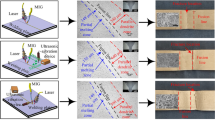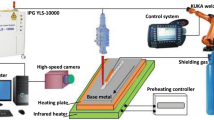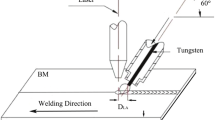Abstract
Severe porosity and coarse columnar grain are prone to be formed in the laser-MIG welded joint of aluminum alloy, deteriorating the strength and ductility seriously. In this study, the ultrasound was designed to assist the laser-MIG hybrid welding of aluminum alloy, and the influence of ultrasonic vibration on weld formation, porosity, and microstructure was investigated. The weld depth was increased from 3.6 to 4.2 mm when external ultrasound with the pressure of amplitude transformer (PAT) of 132 N was used, indicating that the penetration ability of hybrid heat sources to the welded plate could be improved. It was attributed to the dispersion effect of ultrasound on arc plasma in the laser channel. The porosity rate was reduced from 5.66 to 1.05% under PAT of 132 N, because of the increase in escape velocity of bubbles. Moreover, the columnar to equiaxed transformation (CET) of grain in the weld was promoted and the width of columnar grain zone was gradually reduced with the increasing ultrasonic energy, owing to the breaking effect of cavitation and the stirring effect of acoustic stream. As a result, lower porosity rate and finer grain size led to improvement of the microhardness and the strength of weld by ultrasound. The study provides more guidance on employing ultrasound to improve the quality of welded joints.
















Similar content being viewed by others
Data availability
All data are presented within the manuscript.
Code availability
Not applicable.
References
Bi J, Liu L, Wang CY, Chen G, Jia XD, Chen X, Xia HB, Li XP, Starostenkov MD, Han B, Dong GJ (2022) Microstructure, tensile properties and heat-resistant properties of selective laser melted AlMgScZr alloy under long-term aging treatment. Mater Sci Eng, A 833:142527. https://doi.org/10.1016/j.msea.2021.142527
Huang YM, Yuan YX, Feng YC, Liu JP, Yang LJ, Cui L (2022) Effect of activating flux Cr2O3 on microstructure and properties of laser welded 5083 aluminum alloys. Opt Laser Technol 150:107930. https://doi.org/10.1016/j.optlastec.2022.107930
Hagenlocher C, Stritt P, Weber R, Graf T (2018) Strain signatures associated to the formation of hot cracks during laser beam welding of aluminum alloys. Opt Lasers Eng 100:131–140. https://doi.org/10.1016/j.optlaseng.2017.08.007
Hu SD, Hou L, Wang K, Liao ZM, Zhu W, Yi AH, Li WF, Fautrelle Y, Li X (2021) Effect of transverse static magnetic field on radial microstructure of hypereutectic aluminum alloy during directional solidification. J Mater Sci Technol 76:207–214. https://doi.org/10.1016/j.jmst.2020.11.025
Fan YY, Fan CL, Yang CL, Liu WG, Lin SB (2013) Research on short circuiting transfer mode of ultrasonic assisted GMAW method. Sci Technol Weld Joining 17(3):186–191. https://doi.org/10.1179/1362171811y.0000000058
Chen C, Fan CL, Cai XY, Lin SB, Yang CL (2019) Analysis of droplet transfer, weld formation and microstructure in Al-Cu alloy bead welding joint with pulsed ultrasonic-GMAW method. J Mater Process Technol 271:144–151. https://doi.org/10.1016/j.jmatprotec.2019.03.030
Xie WF, Huang T, Yang CL, Fan CL, Lin SB, Xu WH (2020) Comparison of microstructure, mechanical properties, and corrosion behavior of Gas Metal Arc (GMA) and Ultrasonic-wave-assisted GMA (U-GMA) welded joints of Al–Zn–Mg alloy. J Mater Process Technol 277:116470. https://doi.org/10.1016/j.jmatprotec.2019.116470
Wu MX, Wu CS, Gao S (2017) Effect of ultrasonic vibration on fatigue performance of AA 2024–T3 friction stir weld joints. J Manuf Process 29:85–95. https://doi.org/10.1016/j.jmapro.2017.07.023
Chen QH, Ge HL, Yang CL, Lin SB, Fan CL (2017) Study on pores in ultrasonic-assisted TIG weld of aluminum alloy. Metals 7(2):1–10. https://doi.org/10.3390/met7020053
Zhu Q, Lei YC, Wang YL, Huang W, Xiao B, Ye YM (2014) Effects of arc-ultrasonic on pores distribution and tensile property in TIG welding joints of MGH956 alloy. Fusion Eng Des 89(12):2964–2970. https://doi.org/10.1016/j.fusengdes.2014.08.012
Lei ZL, Bi J, Li P, Guo T, Zhao YB, Zhang DM (2018) Analysis on welding characteristics of ultrasonic assisted laser welding of AZ31B magnesium alloy. Opt Laser Technol 105:15–22. https://doi.org/10.1016/j.optlastec.2018.02.050
Liu J, Zhu HY, Li Z, Cui WF, Shi Y (2019) Effect of ultrasonic power on porosity, microstructure, mechanical properties of the aluminum alloy joint by ultrasonic assisted laser-MIG hybrid welding. Opt Laser Technol 119:105619. https://doi.org/10.1016/j.optlastec.2019.105619
Shcheglov PY, Uspenskiy SA, Gumenyuk AV, Petrovskiy VN, Rethmeier M, Yermachenko VM (2011) Plume attenuation of laser radiation during high power fiber laser welding. Laser Phys Lett 8(6):475–480. https://doi.org/10.1002/lapl.201110010
Liu FY, Wang HQ, Meng XY, Tan CW, Chen B, Song XG (2022) Effect of magnetic field orientation on suppressing porosity in steady-magnetic-field-assisted aluminum alloy deep-penetration laser welding. J Mater Process Technol 304:117569. https://doi.org/10.1016/j.jmatprotec.2022.117569
Sarabia R, Gallego-Juárez J, Rodríguez-Corral G, Elvira-Segura L, González-Gómez I (2000) Application of high-power ultrasound to enhance fluid/solid particle separation processes. Ultrasonics 38(1–8):642–646. https://doi.org/10.1016/S0041-624X(99)00129-8
Gallego-Juarez JA (2010) High-power ultrasonic processing: recent developments and prospective advances. Phys Procedia 3(1):35–47. https://doi.org/10.1016/j.phpro.2010.01.006
Wang L, Liu Y, Yang CG, Gao M (2021) Study of porosity suppression in oscillating laser-MIG hybrid welding of AA6082 aluminum alloy. J Mater Process Technol 292:117053. https://doi.org/10.1016/j.jmatprotec.2021.117053
Nampoothiri J, Balasundar I, Raj B, Murty BS, Ravi KR (2018) Porosity alleviation and mechanical property improvement of strontium modified A356 alloy by ultrasonic treatment. Mater Sci Eng, A 724:586–593. https://doi.org/10.1016/j.msea.2018.03.069
Li RQ, Li XQ, Chen PH, Guo X, Zhang M (2016) Effect rules and function mechanism of ultrasonic cavitation on solidification microstructure of large size high-strength aluminum alloy with hot top casting. Journal of Central South University(Science and Technology) 47(10): 3354–3359. https://doi.org/10.11817/j.issn.1672-7207.2016.10.010.
Xu HB, Jian XG, Meek TT, Han QY (2004) Degassing of molten aluminum A356 alloy using ultrasonic vibration. Mater Lett 58(29):3669–3673. https://doi.org/10.1016/j.matlet.2004.02.055
Li JW, Momono T, Tayu Y, Fu Y (2008) Application of ultrasonic treating to degassing of metal ingots. Mater Lett 62(25):4152–4154. https://doi.org/10.1016/j.matlet.2008.06.016
Zhang SL, Zhao YT, Cheng XN, Chen G, Dai QX (2009) High-energy ultrasonic field effects on the microstructure and mechanical behaviors of A356 alloy. J Alloy Compd 470(1):168–172. https://doi.org/10.1016/j.jallcom.2008.02.091
Wang F, Eskin D, Mi JW, Wang CN, Koe B, King A, Reinhard C, Connolley T (2017) A synchrotron X-radiography study of the fragmentation and refinement of primary intermetallic particles in an Al-35 Cu alloy induced by ultrasonic melt processing. Acta Mater 141:142–153. https://doi.org/10.1016/j.actamat.2017.09.010
Yuan T, Kou S, Luo Z (2016) Grain refining by ultrasonic stirring of the weld pool. Acta Mater 106:144–154. https://doi.org/10.1016/j.actamat.2016.01.016
Jian X, Meek TT, Han Q (2006) Refinement of eutectic silicon phase of aluminum A356 alloy using high-intensity ultrasonic vibration. Scripta Mater 54(5):893–896. https://doi.org/10.1016/j.scriptamat.2005.11.004
Xu C, Sheng GM, Cao XZ, Yuan XJ (2016) Evolution of microstructure, mechanical properties and corrosion resistance of ultrasonic assisted welded-brazed Mg/Ti Joint. J Mater Sci Technol 32(12):1253–1259. https://doi.org/10.1016/j.jmst.2016.08.029
Chen C, Fan CL, Cai XY, Lin SB, Yang CL, Zhuo YM (2020) Microstructure and mechanical properties of Q235 steel welded joint in pulsed and un-pulsed ultrasonic assisted gas tungsten arc welding. J Mater Process Technol 275:116335. https://doi.org/10.1016/j.jmatprotec.2019.116335
Li SR, Mi GY, Wang CM (2020) A study on laser beam oscillating welding characteristics for the 5083 aluminum alloy: Morphology, microstructure and mechanical properties. J Manuf Process 53:12–20. https://doi.org/10.1016/j.jmapro.2020.01.018
Chen R, Jiang P, Shao XY, Mi GY, Wang CM, Geng SN, Gao S, Cao LC (2017) Improvement of low-temperature impact toughness for 304 weld joint produced by laser-MIG hybrid welding under magnetic field. J Mater Process Technol 247:306–314. https://doi.org/10.1016/j.jmatprotec.2017.04.004
Funding
This work is supported by the Natural Science Foundation for Excellent Young Scholars of Shandong Province (ZR2021YQ30) and the Natural Science Foundation of Shandong Province of China (ZR2019PEE038).
Author information
Authors and Affiliations
Contributions
Caiwang Tan: validation, methodology, writing-original draft; Bingxiao Xu: methodology, data curation, writing; Fuyun Liu: conceptualization, writing—review and editing; Yixuan Zhao: conceptualization, revision; Danyang Lin: revision; Laijun Wu: revision; Bo Chen: revision; Xiaoguo Song: revision.
Corresponding authors
Ethics declarations
Ethics approval
The article follows the guidelines of the Committee on Publication Ethics (COPE) and involves no studies on human or animal subjects.
Consent to participate
All authors approve the manuscript to participate.
Consent for publication
All authors approve the manuscript to publication.
Conflict of interest
The authors declare no conflict of interest.
Additional information
Publisher's Note
Springer Nature remains neutral with regard to jurisdictional claims in published maps and institutional affiliations.
Rights and permissions
Springer Nature or its licensor holds exclusive rights to this article under a publishing agreement with the author(s) or other rightsholder(s); author self-archiving of the accepted manuscript version of this article is solely governed by the terms of such publishing agreement and applicable law.
About this article
Cite this article
Tan, C., Xu, B., Liu, F. et al. Effect of ultrasonic vibration on porosity suppression and columnar-to-equiaxed transition in laser-MIG hybrid welding of aluminum alloy. Int J Adv Manuf Technol 122, 2463–2474 (2022). https://doi.org/10.1007/s00170-022-10034-4
Received:
Accepted:
Published:
Issue Date:
DOI: https://doi.org/10.1007/s00170-022-10034-4




